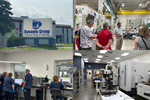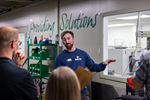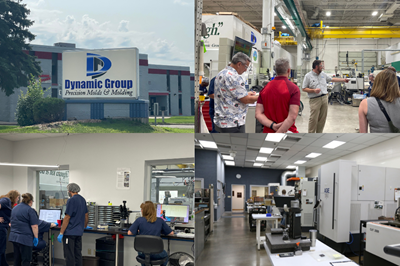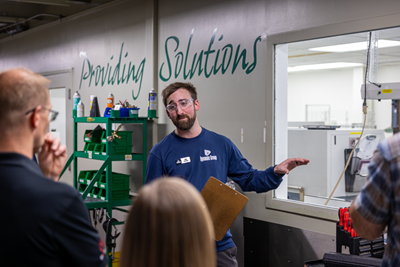
Minnesota-based Dynamic Group is a precision injection mold builder and plastic injection molder operating in two facilities located 11 miles apart built upon the philosophy of early adoption of business practices and technologies. Source (All Images) Dynamic Group
Who is Dynamic Group?
Brian Kalina, director, tooling operations, Dynamic Group: We are a precision injection mold builder and plastic injection molder operating in two facilities located 11 miles apart. The tooling facility, spanning 16,500 square feet with 36 employees (including six apprentices), specializes in tight-tolerance, high-volume production of single- and multi-cavity tooling, focusing primarily on Class 101 and 102 molds.
We also build Class 103 or 104 molds as part of prototype-to-production programs. The injection molding facility, covering 23,500 square feet with more than 60 employees, is ISO13485-certified and specializes in molding and assembling medical devices and parts requiring cleanliness, consistency and traceability.
In 1977, Dave Kalina proposed a partnership with Peter McGillivray to build molds. McGillivray agreed, and the company, initially named Dynamic Engineering, has thrived for 47 years. The company is evenly split between the two families, with Kalina and McGillivray remaining majority shareholders now along with three second-generation shareholders. In addition to my role as an owner/operator, Joe McGillivray is our president and CEO.

Dynamic Group is committed to continued investment in tooling, fixturing and equipment to maintain its mold manufacturing methods.
Dynamic Group’s foundation is built on the philosophy of early adoption of business practices and technology. The company has been a pioneer in departmentalization, owning a wire EDM, obtaining ISO 9001 certification and adding molding capabilities. The moldmaking and molding companies operated separately until 2008, when they merged under one management team.
In 2016, the second generation assumed day-to-day operations, with Joe McGillivray becoming CEO. By 2018, they aimed for growth in molding to account for 70% of the company’s revenue, while maintaining its existing moldmaking capacity and customer base.
When and how did you realize you had to adapt your moldmaking focus to better align with the growth in production molding by shifting the tooling team's focus to maintenance, repair and replacement tooling from new tooling programs?
Kalina: The investment in our engineering and quality departments for molding operations moved us from reactive to proactive. Our tooling operations had always been able to accommodate the urgent requests for repairs as needed, but the type and volume of requests to solve systemic issues with revisions and fixturing rose exponentially.

More than 60 employees work in the injection molding facility, which specializes in molding and assembling medical devices and parts requiring cleanliness, consistency and traceability.
Although we have always been responsive, the continual introduction of such quick-turn projects started to more frequently impact our other commitments. We were having too many internal conversations to justify our priorities and too many conversations with our customers to explain why their projects would be late.
What was the first step and who was involved when making this shift?
Kalina: The first step is always accepting that you have a problem. Immediate support, when needed, had always just been considered an expectation of running a tooling operation, not just for our own molding operations but for most of our tooling customers. This had long been supported primarily through spontaneous overtime.
However, with industry changes regarding employee work-life balance, this continued to be more difficult. Like it or not, our ability to respond this way diminished. We had to first align awareness and acceptance of this new reality with sales and project management to balance and satisfy the two distinct demands for toolroom resources — new tooling and quick response.

Dynamic Group's group has taught the team to make decisions with a greater awareness of capacity, which demands compromise and alignment across the entire team.
We had to evaluate our overall capacity throughout two timeframes, the earlier including not just quick-response projects already in process, but also the reserved capacity for the unknown yet inevitable requests. The discipline not to overcommit new tooling projects into that capacity continues to be challenging. The need, determination and temptation to always sell “any and all” unbooked hours is still deeply ingrained in most of us. Our capacity is still adaptable with overtime and opportunities to sell more into one bucket or the other. However, it is now a decision based upon capacity awareness, compromise and alignment.
What did this shift require in terms of areas that needed to change?
Kalina: People and Training: We were able to transition from an environment that required each engineer to wear every hat to leveraging the skills and experience from a variety of engineering backgrounds in focused roles. We now have designated engineers focused on our quality management system, processing and manufacturing, new product introduction, validation, metrology and document control.

The tool design and planning team collaborates with customers to create the optimal tool for their requirements. They then meticulously plan and schedule the program to ensure on-time delivery, quality and consistency.
Individuals not only have accountability to apply their knowledge and experience to complete their specific tasks at hand, but also ownership to establish best practices and develop processes we can standardize for routine and confident application on all future work.
Representation in the Molding Facility: We have also extended direct representation of our tooling knowledge and capabilities within the molding facility. This includes a dedicated mold maintenance technician, routine rotation of our apprentices and a tooling/project engineer dedicated to intercompany projects, who then also participates on the operations team at the tooling facility to help align their support.
The only dedicated resources are the moldmakers located at each facility.
Communication and Collaboration: When the customer is our molding operation, our tooling/project engineer, manufacturing engineer and mold maintenance technician collaborate to identify the root cause of a possible tooling issue and/or a potential solution. They then include our mold design manager and lead moldmaker from our tooling facility to discuss options and recommendations further.

Technically knowledgeable project manager and skilled toolmakers work as a team to discuss options and recommendations for each project.
Estimations of costs and lead time are determined, and if approved, a work order is generated to provide instruction and document the history of changes applied. These discussions provide tooling operations initial visibility to projects, and even just as potential projects, they are added to scheduling tools for projected consumption of our capacity.
“The better we get, the more capacity we have for getting even better.”
Workflow and Planning Systems: Other than additional proactive project identification, separate capacity planning for quick-response and reserved resource capacity, we already had all the necessary resources and skillsets needed. We have always provided the service. However, with just pure determination and a “we’ll fit it in” attitude, it was too often at the expense of other commitments and/or the frustration of our employees.
Well-Organized/Managed Workflow: Project categories within our ERP account for and trend the various types of support to the molding operations. For example, line-down situations, adjustments during validation or process improvements.
Detailed Planning and Scheduling System: The availability of reserved capacity for quick responses had to be physically represented in our department and machine scheduling tools. We often schedule new tool production around empty buckets of time reserved for the unknown yet inevitable need for those same resources to support our molding operations.
High-Level Engineering and Documentation Processes: Detailed manufacturing planning developed in parallel with the mold design process can influence design and procurement to best leverage our capabilities and standardized manufacturing methods. They are designed to generate repeatable/interchangeable results.

A tooling/project engineer, manufacturing engineer and mold maintenance technician collaborate with customers to determine the root cause of a possible tooling issue and a potential solution.
Collaborative Mold Design: Our mold design team at the tooling facility is an extension of our engineering team. Often, with direct communication and collaboration with our customers, we are viewed as an extension of their engineering teams as well.
Equipment and Processes: Thus far we have been able to effectively schedule the needed capacity in our existing machines, avoiding the need to isolate or purchase dedicated pieces of equipment or to create an entire department dedicated solely to the support of our molding facility.
Reserved daily capacity of all scheduled resources, including three- and five-axis milling, sinker and wire EDMs and polishing resources (that can be deployed directly to the molding facility), is consumed as needed with minimal impact to the new molds scheduled. The only dedicated resources are the moldmakers located at each facility.

Dynamic effectively schedules needed capacity in its existing machines, so they have not had to invest in equipment or build a separate department dedicated to supporting the molding facility.
More recently, we invested in a submersible rotary index in our wire EDMs to manufacture a low volume of small precision core pins instead of outsourcing to a grinding shop. This provides internal control of our lead times for immediate replacement and spare inventory of easily broken, extended length, small-diameter, tight-tolerance core pins often used for many of the medical devices we produce.

Designated engineers focus on quality management system, processing and manufacturing, new product introduction, validation, metrology and document control.
Finally, our Starrett vision system improves the consistency and accuracy of tooling component inspection. Redundancy in some of the same inspection equipment at each facility provides consistency in measurement and alignment in evaluation, as well as backup capacity during calibration or maintenance.
What have been the benefits of this change of focus from new tooling to mold maintenance, repair and replacement tooling?
Kalina: The efficiency of molding operations certainly benefits directly from the combined efforts of production, engineering and tooling. With fewer parts reaching the material review board, there has been a shift from the percentage of requests for tooling that are reactive. There are still many requests for tooling support, but with more opportunities for the engineering team to focus on improvements, they are now proactive projects.

As the molding business grows, the tooling team shifts its focus from new tooling programs to maintenance, repair and replacement tooling. To meet the demands of quick-response projects, which often involve troubleshooting, the Dynamic Group team taps into the skills of its moldmakers and machining specialists who are cross-trained to help address urgent needs.
The better we get, the more capacity we have for getting even better. There has been an indirect benefit too. For new tooling projects, we plan, schedule and process using a routine and departmentalized approach.
However, to satisfy quick-response projects that often require troubleshooting, we leverage moldmakers and machining specialists to apply their cross-training and versatility to meet a more urgent demand. They are more often challenged to apply their experience to in-process discretionary decision-making and they get to experience a different satisfaction for the value and impact they provide to the organization, not just our external customers. This is especially beneficial for the development of the next generation of moldmakers.
What have been the drawbacks?
Kalina: The only drawback so far has been explaining when our adjustments in the allocation of resources to accommodate trending demands or opportunities has swung too far in one direction. There is also a tendency to fall back into firefighting mode when we fail to recognize the combined impact of surging demand across both value streams.
Our investment in resources to support molding has proven beneficial to the company’s bottom line. However, our historical financial metrics specific to tooling are no longer directly comparable. Despite this, management is willing to accept any decrease in traditional tooling value stream performance until the metrics are updated to reflect the shift in resource allocation.
“To satisfy quick-response projects that often require troubleshooting, we leverage moldmakers and machining specialists to apply their cross-training and versatility to meet a more urgent demand.”
Give me some critical lessons learned?
Kalina: In hindsight, we could have sooner expressed the purpose, intent and impact of this service within the tooling facility. We are still striving for more opportunities for moldmakers and machine specialists to routinely experience the impact of their efforts first-hand — whether that be the quality of the product, efficiency of a process or immediate and direct recognition of their effort. The 11 miles between our facilities isn’t much, but across any distance, it takes intention and follow-through to share feedback and appreciation.
What are some plans on the tooling side of the business?
Kalina: There is always the continued investment in tooling, fixturing and equipment to maintain our niche of mold manufacturing methods, including investigating and acquiring additive machining centers. Our continued investment in apprentice recruitment, education and career development remains one of the most challenging yet rewarding paths forward.
With the focus on mold maintenance, repair and replacement tooling, are you considering a certification for mold maintenance?
Kalina: We remain focused on aligning our capacity for reliable response and standardizing expectations with predictable results. Perhaps someday, we may choose to market and leverage our methods and resources as a truly independent value stream. Accredited certifications would certainly validate the knowledge of our individuals and the capabilities of the company, but until then, the confidence we have in our team’s abilities is all that’s needed to be successful.
Related Content
What Is Scientific Maintenance? Part 1
Part one of this three-part series explains how to create a scientific maintenance plan based on a toolroom’s current data collection and usage.
Read MoreWhat is Scientific Maintenance? Part 2
Part two of this three-part series explains specific data that toolrooms must collect, analyze and use to truly advance to a scientific maintenance culture where you can measure real data and drive decisions.
Read MoreWhat You Need to Know About Hot Runner Systems and How to Optimize Their Performance
How to make the most out of the hot runner design, function and performance.
Read More5 Hot Runner Tips for Moldmakers and Molders
Best practices for initial hot runner tryouts and effective preventive maintenance.
Read MoreRead Next
Up Close and Personal With Precision Molds and Molding
MoldMaking Technology's Christina Fuges and Tony Deligio with Plastics Technology were onsite together at the Dynamic Group in Ramsey, Minnesota, to see how its moldmaking and molding capabilities come together to grow the business as part of an AMBA Facility Tour.
Read MoreMedical Molder, Moldmaker Embraces Continuous Improvement
True to the adjective in its name, Dynamic Group has been characterized by constant change, activity and progress over its nearly five decades as a medical molder and moldmaker.
Read MoreAre You a Moldmaker Considering 3D Printing? Consider the 3D Printing Workshop at NPE2024
Presentations will cover 3D printing for mold tooling, material innovation, product development, bridge production and full-scale, high-volume additive manufacturing.
Read More











.jpg;maxWidth=300;quality=90)












